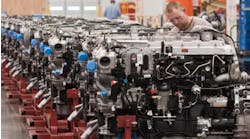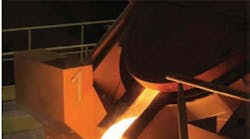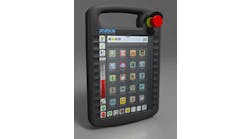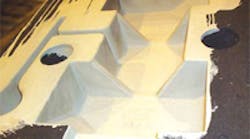This flow-coated mold with the alumina-silica system has many benefits, including improvement in strip and peel on the casting.
Alumina-silica coatings are looking good as a replacement for zircon coatings at Southwest Steel Castings Co., according to Mark Phillips, quality assurance manager. At the 2006 Steel Founders Society Technical & Operating Conference, Phillips reported on a testing program comparing alumina-silica with zircon as a mold- and core-coating material. Testing indicated that the results from using an alumina-silica coating were equal to or better than those from using zircon coatings, he said, further indicating that cost savings could exceed 34%.
Zircon-based coatings have been used in steel foundries for a long time, to produce heavy-section castings. They are effective at reducing or eliminating a variety of casting defects and surface imperfections that occur during casting production.
Zircon has several characteristics that make it effective in these applications, including a high melting point (2,190°C), low thermal expansion, good resistance to abrasion, and high density. It is non-wetting when in contact with molten steel.
Steel foundries, like Southwest Steel Castings in Longview, TX, have paid a premium for zircon-based coatings because of this performance. Recently, however, the global demand for zircon has greatly increased, driving its cost up further.
When it became clear that the cost of zircon coatings was likely to continue increasing, Foseco Inc. (www.foseco.com) approached Southwest Steel about testing an alternative to zircon coatings based on the alumina-silica system. Foseco’s aluminasilica system promised several advantages: it uses North American raw materials, it offers a more stable raw material cost, and the application cost promised to be lower.
Working with Foseco, Southwest Steel developed a testing program to determine if alumina-silica system could substitute for zircon coatings.
The foundry produces castings from 10 to 5,000 lb, at two plants, in various metallurgies and heat-treating combinations for the petroleum, construction, transportation, general, and marine industries.
As a standard procedure, Southwest Steel flow-coats all molds with a zircon-alcohol based solution. The in-gates and areas of high burn-in are swabbed before the first layer of flowcoating is applied. After the flow-coating treatment, the molds are flamed off. Cores and sleeves are set after the flames have diminished.
Cores are brushed and/or sprayed depending on the configuration. Occasionally, a dipping application is used, depending on the size of the core. Phillips reported that future projects may include flow-coating the cores to eliminate the spray and brush applications.
The tests consisted of a small number of heats, but included enough molds to make a valid judgment on the alumina-silica filler systems effectiveness.
Both coatings were applied with the standard production flow-coating equipment.
The alumina-silica based flow-coating was tested on a range of 10- to 500-lb castings, with metal section thicknesses of 1 to 4 inches. Separately, castings from 500 to 5,000 lb with metal section thicknesses of 4 to 10 inches were tested.
In all cases, the results with the alumina-silica-based flowcoating proved to be equal to or better than those with the standard zircon coating.
In addition to improved casting quality, the alumina-silica system showed improvements in several areas: improved detail in casting letter areas, better coating strip and peel after casting, improved rheological properties, and fewer teardrops and runs.
The alumina-silicate coating material also proved to be easy to remix and the coating mixture showed no tendency to form “hard packing” after the mixer was turned off. Also, drum weights of the material proved to be consistent.
Using the alumina-silicate coating material resulted in a reduction in wet coating thickness, which increased the coatings’ “mileage” in both plants. Phillips reported Southwest Steel’s drum consumption is 2,470 lb/day. The alumina-silica consumption was 1,625 lb/day. Based on these usage factors, the in-coming raw-material cost were reduced by approximately 34%, with potential for even greater savings.
Excerpted from FM&T March 2007 issue, pg. 16.




